July: The Meadow Becomes a Garden
The paths are a success! The family walks them every day and says that, “Those paths make the meadow a garden. It is really beautiful – a place to get away.”
The existing field was clearly dominated by cool season grasses that went dormant in the heat of the summer making the meadow glow with gold. The contrast between it and the new, vibrantly green, warm season grasses of the old construction road was stark but beautiful. It was very peaceful to walk along the paths through the golden field. Even though much of the grass had gone dormant, the field was filled with flowers: Milkweed, Queen Anne’s Lace, Morning Glory, Fleabane, Horse Nettle, Mullien, Sweet Woodruff, Clover, Bladder Campion, Cinquefoil, and Dogbane.
The grasses and flowers in the old construction road now felt much more like a garden and less of a derelict area. Standing at about 18 inches, the first to flower in the construction-road field were the Oats. Although they like to take over, Oats can be forgiven when you see their flowers and seeds nodding in the breeze. Blooming with the Oats were Poppies, Cleome, Coreopsis and Baby’s Breath.
The pollinators were in full force: Monarch, Swallowtail, Black Swallowtail, Small White, Painted Lady, and many different Fritillary butterflies; many types of wild bees and domesticated honeybees – from whose hives?? – Praying Mantis and Milkweed Beetles; clouds of gnats; and ants.
There were also pollinator predators including toads, Praying Mantises, and barn swallows.
The fields were very much alive in July but that life was very time-dependent. In early morning and late afternoon birds chirping and pollinators buzzing were loud and constant but as the heat of mid-day set in the fields became quiet. Pollinators still flitted about but they did so quietly so as not to disturb those having a siesta. It was mostly bumblebees that I found snoozing under the leaves.
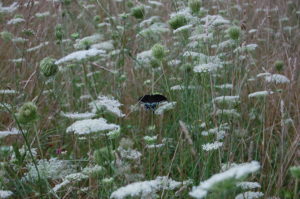
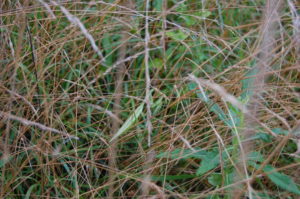
August: The Meadow Becomes a Whole
It felt like all at once that the two fields became one big meadow. The pathways wound through the grasses and flowers and, although one field felt newer than the other, the two melded together to create a cohesive whole. We had planned not to irrigate the meadow. The new, spring- planted trees were watered throughout the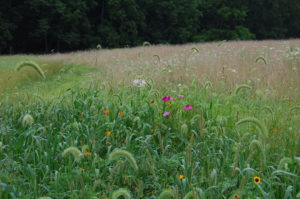
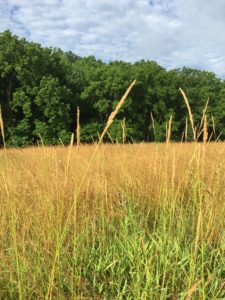 summer and into fall but the meadow itself would have to survive on rain and groundwater. About the third week in August I
summer and into fall but the meadow itself would have to survive on rain and groundwater. About the third week in August I
did break down and water the old construction road flowers – once – for about twenty minutes with a sprinkler; they all looked so sad and I figured the butterflies probably needed a drink, too.
The invasive species kept rearing their heads and I kept cutting them down. They seemed to get smarter and grow just below the flower heads of the grasses so they were too hard to see; HA! I was more clever, and just as persistent!
It became clear during August that there were three distinct areas or microclimates in the existing field: an upper plateau, the middle swath and the lower creek-side area. On the upper plateau the grasses are sparse and limited in height to about 2 feet. Wildflowers are few and far between here. I attribute this to a lack of moisture and the nearly constant west winds. The middle swath covers the south-southeast facing hill. Although there are some small flat areas and varying degrees of slope, the middle swath is relatively consistent. The grasses here are the same species as in the plateau but they grow much more thickly and reach 4-5 feet. There are also many different types of wildflowers in the seed bank. Although some of the same grasses occur in the lower creek-side area, there are many species that only occur here. The wildflowers here are completely different and no Milkweed occurs here. The ‘zone’ extends about 20 feet into the meadow from the creek. The soil is almost always moist; there is an opportunity for designing a wetland habitat garden in the future.
The construction road field has two distinct microclimates: the upper plateau and the middle swath, that follow the same pattern with different types of grasses and flowers.
September: Changing Light and Seed Heads
September brought with it the sharp light and the long shadows of late summer. Life in the meadow remained robust – butterflies, birds, insects, field mice, spiders, and deer abounded. The mown paths were well travelled by people but the creatures created their 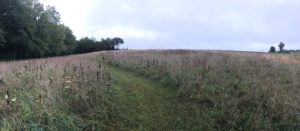 own paths. The deer created highways that crisscrossed through the meadow from the farmed fields around the property to the stream at the base of the hill and on to the shelter of the forest beyond. Late in September the deer became more brazen and started sleeping right in the field – areas of grass looked like large nests where different creatures had bedded down for the night. The cool-season grasses started to grow again, showing a green flash of color below the dormant stalks while the warm season grasses went into dormancy.
own paths. The deer created highways that crisscrossed through the meadow from the farmed fields around the property to the stream at the base of the hill and on to the shelter of the forest beyond. Late in September the deer became more brazen and started sleeping right in the field – areas of grass looked like large nests where different creatures had bedded down for the night. The cool-season grasses started to grow again, showing a green flash of color below the dormant stalks while the warm season grasses went into dormancy.
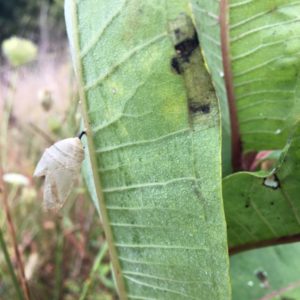
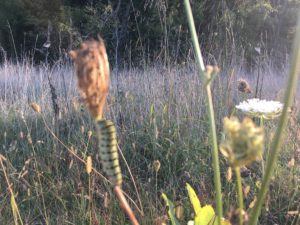 Throughout the growing season grasses had gone to seed at different times and it was not as noticeable as when the flowers started to spread their seed.
Throughout the growing season grasses had gone to seed at different times and it was not as noticeable as when the flowers started to spread their seed.
Milkweed is a survivalist. From mid-September all the way through October, within a single, little plant community there were dead stalks, stalks with mature and open seed pods, green stalks with closed green pods, green stalks with all of their leaves and brand new plants coming up. My wishful thinking was that this is to ensure the Monarch has a food source even late in the season. And there were new Monarchs hatching every day. In reality it was probably to ensure the community could survive mowing.
The Queens Anne’s Lace habit is similar to the Milkweed in having various stages of growth happening simultaneously. But other field plants don’t follow this course. 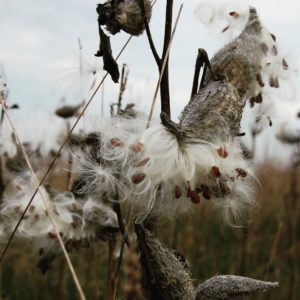
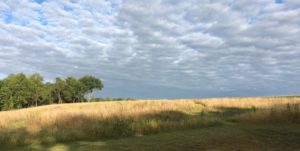
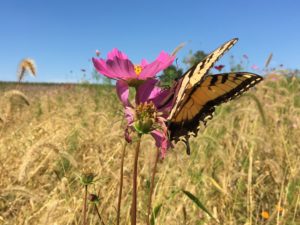
The Horse Nettle fruits seem to appear all at once and the Aster and Mullien flowers seem to go to seed at the same time. Of course, the unwanted thistle goes to seed in the blink of an eye at any time of year making it tricky to control.
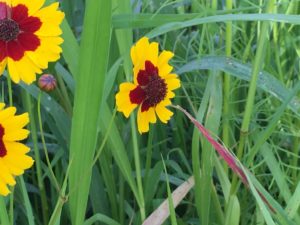
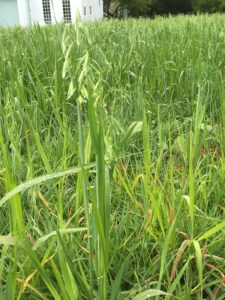
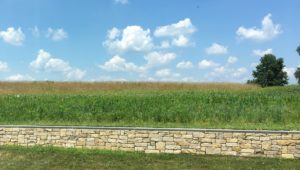

{ 1 trackback }